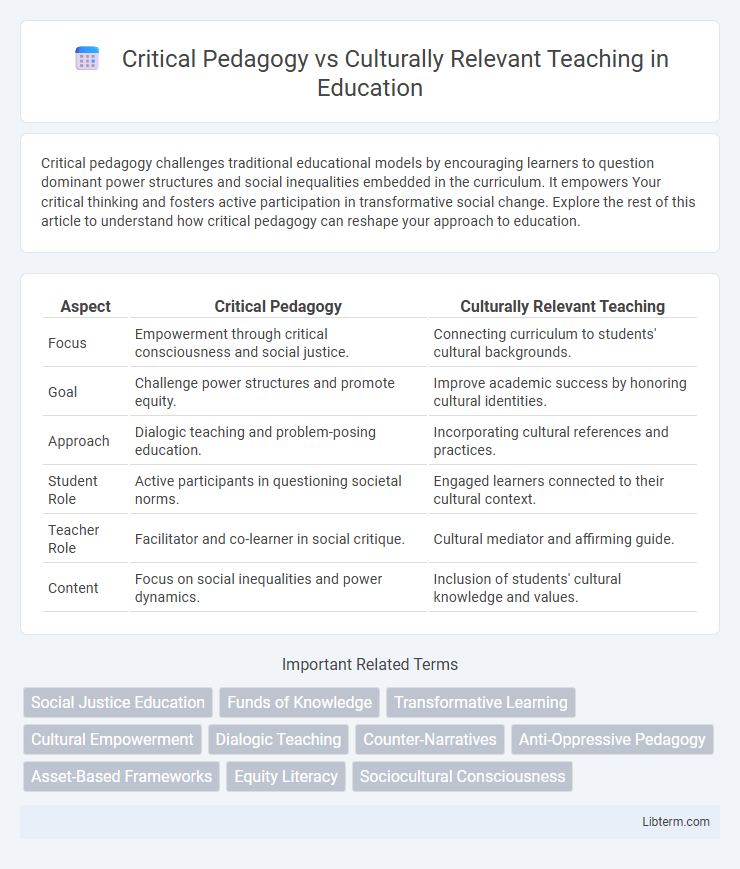Critical pedagogy challenges traditional educational models by encouraging learners to question dominant power structures and social inequalities embedded in the curriculum. It empowers Your critical thinking and fosters active participation in transformative social change. Explore the rest of this article to understand how critical pedagogy can reshape your approach to education.
Table of Comparison
| Aspect | Critical Pedagogy | Culturally Relevant Teaching |
|---|---|---|
| Focus | Empowerment through critical consciousness and social justice. | Connecting curriculum to students' cultural backgrounds. |
| Goal | Challenge power structures and promote equity. | Improve academic success by honoring cultural identities. |
| Approach | Dialogic teaching and problem-posing education. | Incorporating cultural references and practices. |
| Student Role | Active participants in questioning societal norms. | Engaged learners connected to their cultural context. |
| Teacher Role | Facilitator and co-learner in social critique. | Cultural mediator and affirming guide. |
| Content | Focus on social inequalities and power dynamics. | Inclusion of students' cultural knowledge and values. |
Introduction to Critical Pedagogy and Culturally Relevant Teaching
Critical Pedagogy, developed by Paulo Freire, emphasizes the role of education in challenging social injustices and empowering marginalized communities through critical thinking and dialogue. Culturally Relevant Teaching, introduced by Gloria Ladson-Billings, focuses on leveraging students' cultural backgrounds to enhance learning and academic success while promoting cultural competence. Both approaches aim to transform traditional education by fostering inclusivity, critical awareness, and student agency within diverse classrooms.
Historical Foundations of Critical Pedagogy
Critical Pedagogy, rooted in the works of Paulo Freire, emerged during the 1970s as a response to traditional education systems that perpetuated social inequalities. This approach emphasizes the historical context of oppression, encouraging learners to critically examine power structures and engage in transformative action. In contrast, Culturally Relevant Teaching centers on affirming students' cultural identities while promoting academic success, but it often does not foreground the systemic critiques foundational to Critical Pedagogy.
Origins and Evolution of Culturally Relevant Teaching
Culturally Relevant Teaching originated in the late 20th century through the work of Gloria Ladson-Billings, emphasizing the importance of students' cultural backgrounds in shaping educational experiences. This pedagogical approach evolved as a response to traditional methods that often marginalized minority students, promoting academic success, cultural competence, and critical consciousness within the classroom. The evolution of Culturally Relevant Teaching highlights its role in fostering inclusive education by integrating students' heritage, thereby influencing contemporary educational theories and practices.
Core Principles of Critical Pedagogy
Critical Pedagogy centers on empowering students to challenge and question dominant power structures through critical consciousness and praxis, emphasizing dialogue, reflection, and action for social justice. It promotes education as a tool for emancipation, encouraging learners to critically analyze societal inequalities and transform oppressive systems. Core principles include fostering critical thinking, promoting student agency, and integrating real-world issues to connect learning with social change.
Key Aspects of Culturally Relevant Teaching
Culturally Relevant Teaching emphasizes validating students' cultural backgrounds by integrating their identities, experiences, and perspectives into the curriculum to promote academic success and cultural competence. It centers on three key components: academic achievement, cultural competence, and sociopolitical consciousness, enabling students to critically navigate and challenge social inequalities. This approach fosters a dynamic classroom environment where diverse cultural knowledge is a foundation for learning, empowering students to connect their heritage to educational content.
Comparative Analysis: Goals and Objectives
Critical Pedagogy aims to empower students to challenge social injustices and foster transformative change by emphasizing critical consciousness and political awareness. Culturally Relevant Teaching focuses on academic success, cultural competence, and sociopolitical awareness by validating students' cultural identities within the learning environment. While both approaches strive for equity and student engagement, Critical Pedagogy prioritizes systemic critique and activism, whereas Culturally Relevant Teaching balances cultural affirmation with academic achievement.
Teacher’s Role and Classroom Dynamics
Critical Pedagogy positions the teacher as a facilitator who challenges societal inequalities and empowers students to question dominant narratives, fostering a classroom dynamic centered on dialogue and social justice. In contrast, Culturally Relevant Teaching emphasizes the teacher's role in validating and incorporating students' cultural backgrounds into the curriculum, promoting engagement and academic success within a culturally affirming environment. Both approaches transform traditional teacher-centered models by encouraging critical thinking and respect for diverse perspectives, reshaping classroom interactions to support equity and inclusivity.
Impact on Student Engagement and Achievement
Critical Pedagogy emphasizes empowering students to question and challenge societal inequalities, fostering deep critical thinking and active participation in learning processes, which can enhance engagement by connecting education to social justice. Culturally Relevant Teaching prioritizes affirming students' cultural identities and backgrounds, improving academic achievement by making content relatable and accessible, thereby increasing motivation and comprehension. Both approaches significantly impact student engagement and achievement by addressing diverse learner needs through either critical consciousness or cultural affirmation.
Challenges and Critiques in Implementation
Critical Pedagogy faces challenges in implementation due to its emphasis on power dynamics and social justice, which can encounter resistance in traditional educational systems and among educators untrained in critical theories. Culturally Relevant Teaching often struggles with the risk of reinforcing cultural stereotypes if not applied thoughtfully, alongside difficulties addressing diverse student backgrounds within standardized curricula. Both approaches require extensive teacher training and systemic support to effectively navigate institutional barriers and avoid superficial applications that undermine their transformative goals.
Future Directions and Integration in Education
Future directions in Critical Pedagogy and Culturally Relevant Teaching emphasize deeper integration of socio-political consciousness with culturally affirming practices to enhance student empowerment and academic success. Emerging educational frameworks prioritize blending critical consciousness with culturally responsive curricula to address systemic inequities while honoring diverse cultural identities. Research increasingly supports interdisciplinary approaches that combine Critical Pedagogy's transformative aims with the inclusive strategies of Culturally Relevant Teaching, fostering more equitable and engaging learning environments.
Critical Pedagogy Infographic

 libterm.com
libterm.com